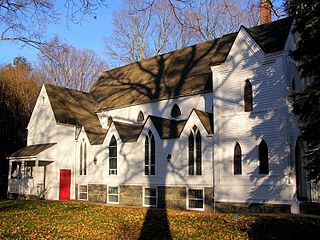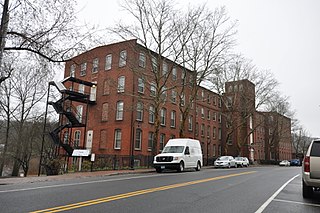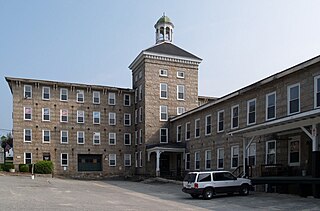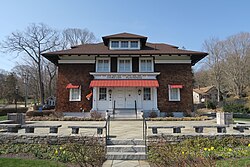History and historic district
Ivoryton is roughly bounded by Main Street, North Main Street, Oak Street, Blake Street, Summit Street, Park Road, and Comstock Avenue. [1] The area is known as a "well-preserved example of a nineteenth-century company town" and a world center of the ivory industry. [1]
The area became industrialized when Comstock, Cheney & Company, an ivory import business founded by Samuel Merritt Comstock, an Ivoryton native, and his partner George A. Cheney in the 1860s was founded there. [1] The district was one of several industrial areas in the Connecticut River Valley established during the late nineteenth century, and is also historically significant as a center for immigrants from Sweden, Germany, Italy, and Poland, who lived in worker housing areas throughout Ivoryton. [1]
Pratt, Read & Company was located just a few miles away from Comstock, Cheney & Company along the Connecticut River, and these two largest American ivory manufacturers "commanded a monopoly on all ivory production in the United States." [1] The area thrived between 1860 and 1938, and at its height the area employed and housed up to 600 workers. [1] The National Register of Historical Places states:
- "The historic district consists of early Colonial structures representing the agrarian village before its industrial transformation, mid- to late-nineteenth-century ivory processing and manufacturing buildings, high-style Victorian homes for company executives, modest vernacular homes and tenements for factory workers, and public buildings such as churches, a post office, company store, library, and a town meeting hall. Although some of the factory buildings have been demolished, the industry-defining bleach houses are gone, many houses have been remodeled, and the village itself sustained damage in a flood in 1982, Ivoryton's historic character remains intact as an example of a planned community not unlike more formalized 'company towns' in an industry unique to the Connecticut River Valley. The period of significance ranges from the construction of earliest known extant building (Joseph Parker Homestead; ca. 1719) to the divestment of company-owned housing in 1938." [1]

Deep River is a town in Middlesex County, Connecticut. The population was 4,415 at the 2020 census. The town center is designated by the U.S. Census Bureau as a census-designated place (CDP). Deep River is part of what the locals call the "Tri-town Area", made up of the towns of Deep River, Chester, and Essex.

Essex is a town in Middlesex County, Connecticut, United States. The population was 6,733 at the 2020 census. It is made up of three villages: Essex Village, Centerbrook, and Ivoryton.

The Mechanic Street Historic District encompasses a historic 19th-century mill and mill village in a 14-block area of the Pawcatuck section of Stonington, Connecticut. Extending along the Pawcatuck River and south of West Broad Street, the area includes a large brick mill complex on the banks of the river, and a neighborhood of well-preserved worker housing on the road grid to its west. The district was listed on the National Register of Historic Places in 1988.

The Ivoryton Playhouse is a small professional theater located in the village of Ivoryton in the town of Essex, Connecticut, US. The theatre is believed to be the first continuously operating, self-supporting summer theatre in the United States and is listed in the National Register of Historic Places. It produces shows year round, March through December. As Comstock-Cheney Hall, it is listed in the National Register of Historic Places.

The Cheney Brothers Historic District was a center of the silk industry in Manchester, Connecticut, in the late 19th and early 20th century. The 175-acre (71 ha) district in includes over 275 mill buildings, workers houses, churches, schools and Cheney family mansions. These structures represent the well-preserved company town of the Cheney Brothers silk manufacturing company, the first America-based silk company to properly raise and process silkworms, and to develop the difficult techniques of spinning and weaving silk. The area was declared a National Historic Landmark in 1978.
Newhallville is a neighborhood in the city of New Haven, Connecticut, named for industrialist George Newhall.

Quinebaug Mill–Quebec Square Historic District is a historic district roughly bounded by the Quinebaug River, Quebec Square, and Elm and S. Main Streets in the town of Brooklyn in Windham County, Connecticut. The district encompasses a well-preserved 19th-century mill village. It was added to the National Register of Historic Places in 1985.

The Georgetown Historic District is a historic district which covers the central portion the village of Georgetown, Connecticut. The district includes parts of Georgetown in the towns of Redding, Weston, Wilton, and Ridgefield and consists of the former Gilbert & Bennett manufacturing plant, institutional housing built for the plant workers, other private homes, and the Georgetown business district.

The Pine Meadow Historic District encompasses most of the historic 19th-century village of Pine Meadow in New Hartford, Connecticut. Located at a bend in the West Branch of the Farmington River southeast of New Hartford center, it is a well-preserved example of a rural industrial village. The district was listed on the National Register of Historic Places in 1996.

The Central Village Historic District is a historic district in the Central Village area of Plainfield, Connecticut that was listed on the National Register of Historic Places (NRHP) in 1991. It encompasses a late 19th-century historic mill village, including a small commercial center where Connecticut Route 12 and 14 meet, a cluster of architecturally distinguished buildings built by mill owners and managers, and a collection of mill worker housing units. It includes the Plainfield Woolen Company Mill, which is separately listed, as well as archaeological remnants of other mill infrastructure. It also includes Plainfield's old town hall and high school. Other architecturally prominent buildings include the c. 1855 Italianate mansion of mill owner Arthur Fenner, and the 1845 Greek Revival Congregational Church.

The Cushman Village Historic District is a historic district encompassing a portion of the Cushman Village area of Amherst, Massachusetts, which was a significant mill village during the 19th century. It is centered on the triangle formed by Bridge, Henry, and Pine Streets in northeastern Amherst, and arose because of the presence of falls on the Mill River, whose water power was harnessed for mills as early as the mid-18th century. Two houses survive from the colonial period. The village, although it was defined for many years by the mills, no longer has any industrial buildings, as they were demolished or destroyed by fire. Most of the houses in the district were built before 1860, the peak of the village's industrial activity. The district was listed on the National Register of Historic Places in 1992.

The Yantic Falls Historic District encompasses a historic mill and associated worker housing on Yantic Street in Norwich, Connecticut. The 10-acre (4.0 ha) area includes a complex of mill buildings, mainly built in brick, and mill worker housing, also out of brick. The area's industrial history dates to the early 19th century. The district was listed on the National Register of Historic Places on June 28, 1972.

The Pratt, Read and Company Factory Complex is an historic industrial facility located in Deep River, Connecticut. Established in 1863 by Pratt-Read and significantly enlarged in 1914, it was one of the principal sites of ivory processing in Connecticut, production combs, buttons, and piano keys. The complex was listed on the National Register of Historic Places on August 30, 1984. It has been converted to residences.

The Belltown Historic District encompasses the historic commercial and industrial main village of East Hampton, Connecticut. Settled in the 18th century, the community flourished in the 19th century as a center of bell making, with numerous firms engaged in the trade. The town center is reflective of this 19th-century success, with a broad diversity of period architecture, as well as surviving elements of the bellmaking industry. The district was listed on the National Register of Historic Places in 1985.

The Hadlyme North Historic District is an 81-acre (33 ha) historic district located in the southwest corner of the town of East Haddam, Connecticut. It represents the historic core of the village of Hadlyme, which straddles the town line, and consists primarily of two north-south roads, Town Street. The village arose around a church society founded in 1743, and grew with the development of small industries along area waterways. It was listed on the National Register of Historic Places in 1988.

The Curtisville Historic District encompasses a predominantly residential area along Naubuc Avenue and Pratt Streets in northwestern Glastonbury, Connecticut. Developed mainly in the 19th century, it illustrates the coexistence of agricultural and industrial pursuits in a single village area, mixing worker housing, former farm properties, and a small mill complex. The district was listed on the National Register of Historic Places in 1992.

The Manchester Historic District encompasses a historic planned industrial and residential area of Manchester, Connecticut. Located west of the town's Main Street area, the district includes most of the Cheney Brothers Historic District, a National Historic Landmark District covering the silk manufacturing mills, worker housing, and owner residences of the Cheney family, as well as other surrounding residential areas related to the growth and development of Manchester under the Cheney's influence. The district was listed on the National Register of Historic Places in 2000.

The Union Village Historic District encompasses the core of a historic 19th-century residential mill village in Manchester, Connecticut. Radiating north and west from the junction of Union Street and North Main Street, the area was developed in the first half of the 19th century has a company town, but evolved into a mixed working-class community in the 20th century. It was listed on the National Register of Historic Places in 2002.

The South Willington Historic District is a historic district encompassing the historic village of South Willington in the town of Willington, Connecticut. The village, mostly stretched along Connecticut Route 32, developed as a 19th-century industrial mill village associated with the Gardiner Hall Jr. Company. The district was listed on the National Register of Historic Places in 2017.

The Manchaug Village Historic District is a historic district encompassing the 19th century industrial village center of Manchaug in Sutton, Massachusetts. Developed in the 1820s around textile mills on the Mumford River, it was the largest industrial area in Sutton, with at least three mill complexes in operation. The district is centered on the junction of Main Street with Manchaug, Putnam Hill, and Whitins Roads.























